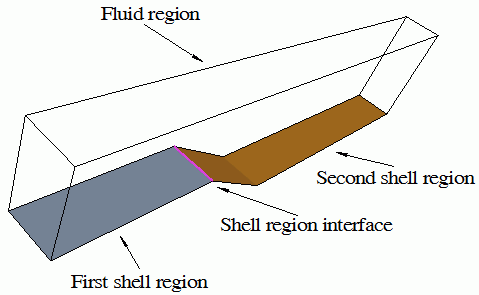Fluid Film
Problems where a thin film of fluid exists on solid boundaries are common in engineering practice. Examples include fluid film on the internal surfaces of automotive engines, gas turbines, spray-cooling systems and ink-jet printers.
Depending on the conditions, complex interactions can occur between the fluid film and the surrounding environment. These interactions require further mathematical modeling to capture the details of the developed flows. The Fluid Film model in Simcenter STAR-CCM+ provides a mathematical description of the behavior of such films. Examples of physical processes that can be modeled with fluid films include gravity driven flow, shear forces on the film interface, external forcing through user-defined momentum source terms and evaporative cooling.

There are different methods by which a film can be formed and removed:
- You can specify the properties of an initial layer of fluid film on a boundary surface.
- A fluid film can flow from a fluid film inlet, and can be removed at an outlet.
- You can specify both a fluid film mass source and a fluid film mass sink to form or remove a fluid film.
- A film can be formed as droplets impact boundary surfaces. For this method, you define injectors for fluid particles with the Lagrangian Multiphase model and a Film-Lagrangian Phase Interaction model with impingement. You can also model the impingement of a dispersed Eulerian phase on a surface to form a fluid film.
It is also possible to model the stripping of droplets from the surface of a fluid film due to wave-induced instabilities or sharp-angled edges. Droplets that are formed in this way are later tracked using the Lagrangian Multiphase model.
- A film can be formed as a gas, or gas
component, condenses onto a surface. The film can be removed as liquid evaporates
from the surface.
For this method, define a Film-VOF Phase Interaction (for VOF Multiphase simulations) or a Film-Physics Continuum Interaction (for all other simulations) together with the Film Evaporation and Condensation model. The Film Boiling model is available as an extension of the Film Evaporation and Condensation model.
You can model fluid film melting and solidification. Simcenter STAR-CCM+ also supports multi-component fluid film models: you can model a mixture of different species components within the film. It is also possible to simulate reactions within the fluid film (see Reacting Species Transport Workflow), or between the fluid film and the surrounding gas phase (see Interphase Workflow: Fluid Film). You can also capture secondary current distributions in the fluid film that are due to electrochemical reactions.
Although a fluid film usually comprises one or more liquid components, solid components can be included. Any solid components are modeled as particles suspended in the fluid, a mixture that is commonly known as a slurry. Example applications for fluid film slurries include airfoil icing where the impinging droplets are part liquid water and part solid ice, and spray drying of droplets on a heated wall.
Shell Regions
A fluid film is not modeled directly within a regular Simcenter STAR-CCM+ region. Instead, Simcenter STAR-CCM+ uses a shell region that you create as the space within which the fluid film flows.
A shell region is a surface domain in space. The region is effectively two-dimensional—only one cell thick—and its boundaries are edges. Shell regions can be created from existing region boundaries.
One shell region is joined to a region or another shell region using an interface. When you create a shell region, an interface between the original fluid region and the shell region is created automatically at the boundary that you selected for creating the shell region.
When the fluid film is expected to flow over multiple shell regions, an interface must exist between them. These different shell regions are created from boundaries belonging to different regions. Similarly, if shell regions have been created separately within a region, create an interface manually between them.

Simcenter STAR-CCM+ supports motions and moving reference frames for fluid film simulations.